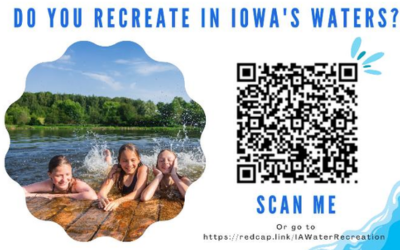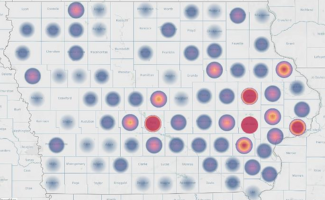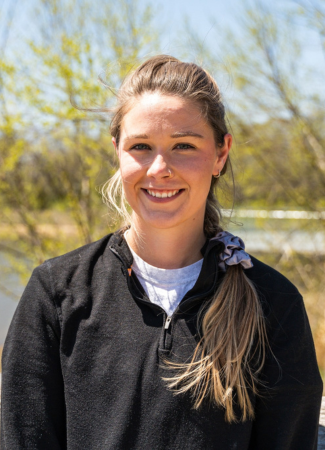Iowa Water Recreation Survey: Do You Recreate in Iowa's Waters?
posted
by Guest Blogger on Tuesday, April 9, 2024
Do You Recreate in Iowa’s Waters?
In 2023, as a part of the Iowa Healthy Lakes Initiative (IHLI), the Iowa Water Recreation Survey (IWRS) was shared online to collect data on recreators throughout Iowa. The survey aimed to gain a better understanding of what Iowans know about harmful algal blooms (HABs) and their potential toxic effects. Additionally, the IWRS assessed behavior in response to a HAB and the effectiveness of current risk communication methods.
Dispersed to a wide network, the IWRS was shared with university students, faculty, and staff, non-profits, public health departments, conservation groups, and recreational clubs through social media, newsletters, flyers, email blasts, and word-of-mouth.
- 1,638 respondents throughout the state

Key Findings
- An increased awareness of the negative health effects associated with HAB exposure, as compared to similar surveys in Iowa (Center for Agricultural and Rural Development, 2021).
- Recreation, particularly water-based, is important to Iowans, although a majority expressed concern regarding the quality of water resources in the state.
- Communication preferences are largely similar to current systems, with an emphasis on signage and increased use of social media.
Respondents were concentrated in Iowa’s urban centers. The average respondent was most likely to be female, holding an advanced degree, and working in healthcare. The demographic bias reflects the researcher’s network and the target audience, those who recreate in Iowa lakes as they would be the most likely group of people to be exposed. Additional effort needs to be made to reach underrepresented groups that may have a high likelihood of exposure or be more likely to utilize resources at a state park.
 So, Can I Go Swimming?
So, Can I Go Swimming?
Only 2.8% of land in Iowa is public, ranking 47th compared to the other states. Despite this, Iowans place a large value on recreation; $1 billion in direct spending is generated from visits to Iowa lakes each year (Iowa Lakes Valuation Project, 2019).
- Predominantly, Iowans are utilizing the recreational areas available to them, visiting at least twice a year. Many visit monthly or even weekly.
- Most people engage in activities like hiking, swimming, walking their dog, or bird watching and are often near the water, if not in it.
36.5% of residents surveyed are leaving the state to seek their quality time with water elsewhere, nearly the same amount remains, as an out of state trip isn’t feasible for many families. 75% of respondents indicated concern for the quality of water in Iowa. Nearly the same proportion of Iowans interviewed in “Water Issues in Iowa” (Conservation Learning Group) viewed the quality of surface water as fair or poor.
The majority of those with concern said they would use Iowa’s resources more if the quality of water improved; some were still unsure.
Duckweed or Danger?
Largely, Iowans have heard the term “HAB”. Perhaps from events like the 2014 Toledo Water Crisis receiving national news coverage or a sign at their local beach warning that “swimming is strongly discouraged.”
Half of respondents indicated they know what HABs are or what they look like, often described as looking like pea soup or spilled paint on the water. When presented with a photo example of a HAB, about the same number of people confirmed seeing a bloom in Iowa. It’s common to mistake non-toxic green filamentous algae or duckweed for a HAB. Perhaps overly cautious but, over half of Iowans surveyed are aware how exposure to a toxic bloom could harm human or animal health.
- Symptoms of HAB-related illness can range from nausea, vomiting, or headache to a loss in coordination, dizziness, or tingling sensations. Severe cases can result in liver failure or death by respiratory paralysis.
- The severity of symptoms depends on the amount of toxin a person is exposed to in the water and the amount of time they were exposed.
Communicating Risk
Iowans surveyed suggested a strong preference for the IA Department of Natural Resources (IDNR) to receive necessary recreational information. Social media was a close second. Most respondents reported typically using Facebook and following groups local to them like the Iowa City Open Water Swimming Club (iCows) or Johnson County Conservation.
Consistent with current usage, respondents prefer to check a specific website for lake conditions, such as the IDNR Beach Monitoring Program or Iowa Environmental Council’s (IEC) Water Watch. Respondents also indicated wanting to find their recreational information on social media, perhaps relying on a specific group to keep them consistently informed.
Despite the current age of social media, survey results showed the importance of physical signage. The last line of defense to warn recreators, ultimately letting them decide if the risk of getting sick is enough to refrain from using the lake, whether that decision be for themselves, children, or pets.
.png)
Some respondents, albeit a smaller number, suggested that the local news stations or Iowa Public Radio (IPR) should communicate this information. Some indicated wanting to receive a weekly text or email, the latter already available through IEC’s Weekly Water Watch newsletter.
- Children and animals are much more vulnerable to HAB-related illness due to their playful nature and smaller body weight.
- 85% of respondents reported changing their behavior in response to a HAB advisory by actively avoiding the water or not swimming. A small percentage said that they would still use the lake, but they wouldn’t put their head underwater.
.png)
Green Doesn’t Mean Go
- Check the condition of the lake before you go.
- When in doubt, stay out.
- Do not let children or dogs swim in green water.
- Shower or rinse off after swimming in a lake.
- Call your doctor or visit an urgent care clinic if you experience symptoms associated with HAB-related illness.
- For more information and a full list of symptoms, visit the Centers for Disease Control and Prevention (CDC).
- For more resources on HABs in Iowa, visit @iowahabs online.
About the Author
 Lyndy Holt received a degree in biology and environmental science from the University of Dubuque in 2021 where she was engaged in climate change research focused on measuring ecological impacts to the Mississippi River.
Lyndy Holt received a degree in biology and environmental science from the University of Dubuque in 2021 where she was engaged in climate change research focused on measuring ecological impacts to the Mississippi River.
In 2023 she graduated with a Master’s Degree in occupational and environmental Health from the College of Public Health at the University of Iowa. There, she worked in the Human Toxicology and Exposomics Laboratory as a part of the multi-disciplinary Iowa Healthy Lakes Initiative, studying human exposure to cyanotoxins and Iowan’s understanding, perception, and communications as related to harmful algal blooms.
This work is being continued at the Iowa Lakeside Laboratory in the Great Lakes Region of northwest Iowa where she is currently serving a term as an environmental steward through the Green Iowa AmeriCorps program.
- beach advisories
- dnr
- e. coli
- environmental justice
- harmful algal blooms
- microcystin
- public beaches
- toxic algae
- water quality
- water recreation